An Overview of Cloud Computing Services Providers
VerifiedAdded on 2022/08/16
|19
|3926
|439
AI Summary
CLOUD COMPUTING SERVICES CLOUD COMPUTING SERVICES 17 17 CLOUD COMPUTING SERVICES CLOUD COMPUTING SERVICES Name of student Name of university Author’s note: 1) Analyse of the leading providers of cloud computing services In this context, three cloud service platforms are chosen and a comprehensive overview is provided regarding these three cloud service platforms which include amazon web service or AWS, Goggle cloud platform and Microsoft Azure. These three platforms are most popular and leading cloud service platforms in the
Contribute Materials
Your contribution can guide someone’s learning journey. Share your
documents today.

Running head: CLOUD COMPUTING SERVICES
CLOUD COMPUTING SERVICES
Name of student
Name of university
Author’s note:
CLOUD COMPUTING SERVICES
Name of student
Name of university
Author’s note:
Secure Best Marks with AI Grader
Need help grading? Try our AI Grader for instant feedback on your assignments.
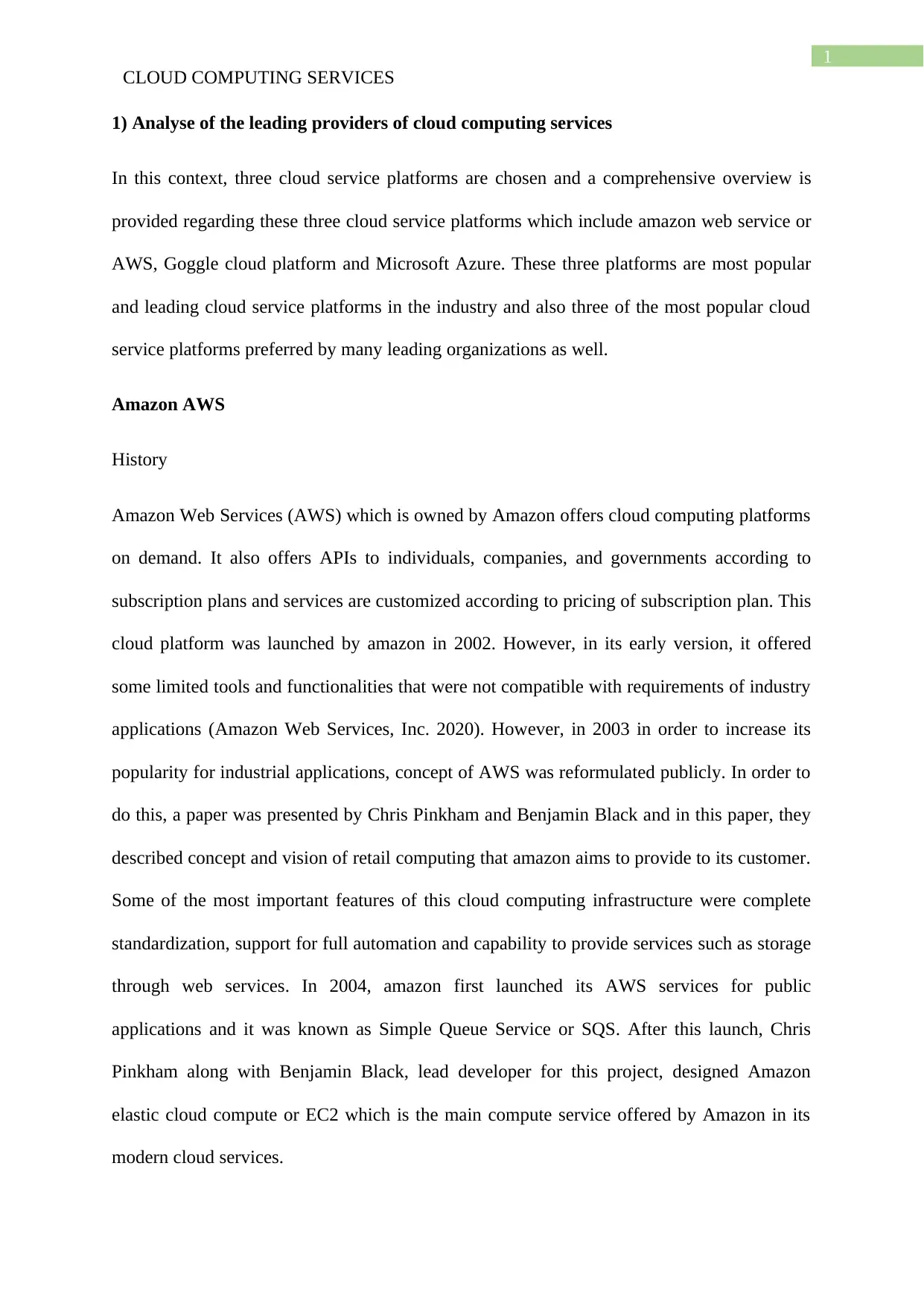
1
CLOUD COMPUTING SERVICES
1) Analyse of the leading providers of cloud computing services
In this context, three cloud service platforms are chosen and a comprehensive overview is
provided regarding these three cloud service platforms which include amazon web service or
AWS, Goggle cloud platform and Microsoft Azure. These three platforms are most popular
and leading cloud service platforms in the industry and also three of the most popular cloud
service platforms preferred by many leading organizations as well.
Amazon AWS
History
Amazon Web Services (AWS) which is owned by Amazon offers cloud computing platforms
on demand. It also offers APIs to individuals, companies, and governments according to
subscription plans and services are customized according to pricing of subscription plan. This
cloud platform was launched by amazon in 2002. However, in its early version, it offered
some limited tools and functionalities that were not compatible with requirements of industry
applications (Amazon Web Services, Inc. 2020). However, in 2003 in order to increase its
popularity for industrial applications, concept of AWS was reformulated publicly. In order to
do this, a paper was presented by Chris Pinkham and Benjamin Black and in this paper, they
described concept and vision of retail computing that amazon aims to provide to its customer.
Some of the most important features of this cloud computing infrastructure were complete
standardization, support for full automation and capability to provide services such as storage
through web services. In 2004, amazon first launched its AWS services for public
applications and it was known as Simple Queue Service or SQS. After this launch, Chris
Pinkham along with Benjamin Black, lead developer for this project, designed Amazon
elastic cloud compute or EC2 which is the main compute service offered by Amazon in its
modern cloud services.
CLOUD COMPUTING SERVICES
1) Analyse of the leading providers of cloud computing services
In this context, three cloud service platforms are chosen and a comprehensive overview is
provided regarding these three cloud service platforms which include amazon web service or
AWS, Goggle cloud platform and Microsoft Azure. These three platforms are most popular
and leading cloud service platforms in the industry and also three of the most popular cloud
service platforms preferred by many leading organizations as well.
Amazon AWS
History
Amazon Web Services (AWS) which is owned by Amazon offers cloud computing platforms
on demand. It also offers APIs to individuals, companies, and governments according to
subscription plans and services are customized according to pricing of subscription plan. This
cloud platform was launched by amazon in 2002. However, in its early version, it offered
some limited tools and functionalities that were not compatible with requirements of industry
applications (Amazon Web Services, Inc. 2020). However, in 2003 in order to increase its
popularity for industrial applications, concept of AWS was reformulated publicly. In order to
do this, a paper was presented by Chris Pinkham and Benjamin Black and in this paper, they
described concept and vision of retail computing that amazon aims to provide to its customer.
Some of the most important features of this cloud computing infrastructure were complete
standardization, support for full automation and capability to provide services such as storage
through web services. In 2004, amazon first launched its AWS services for public
applications and it was known as Simple Queue Service or SQS. After this launch, Chris
Pinkham along with Benjamin Black, lead developer for this project, designed Amazon
elastic cloud compute or EC2 which is the main compute service offered by Amazon in its
modern cloud services.

2
CLOUD COMPUTING SERVICES
CLOUD COMPUTING SERVICES
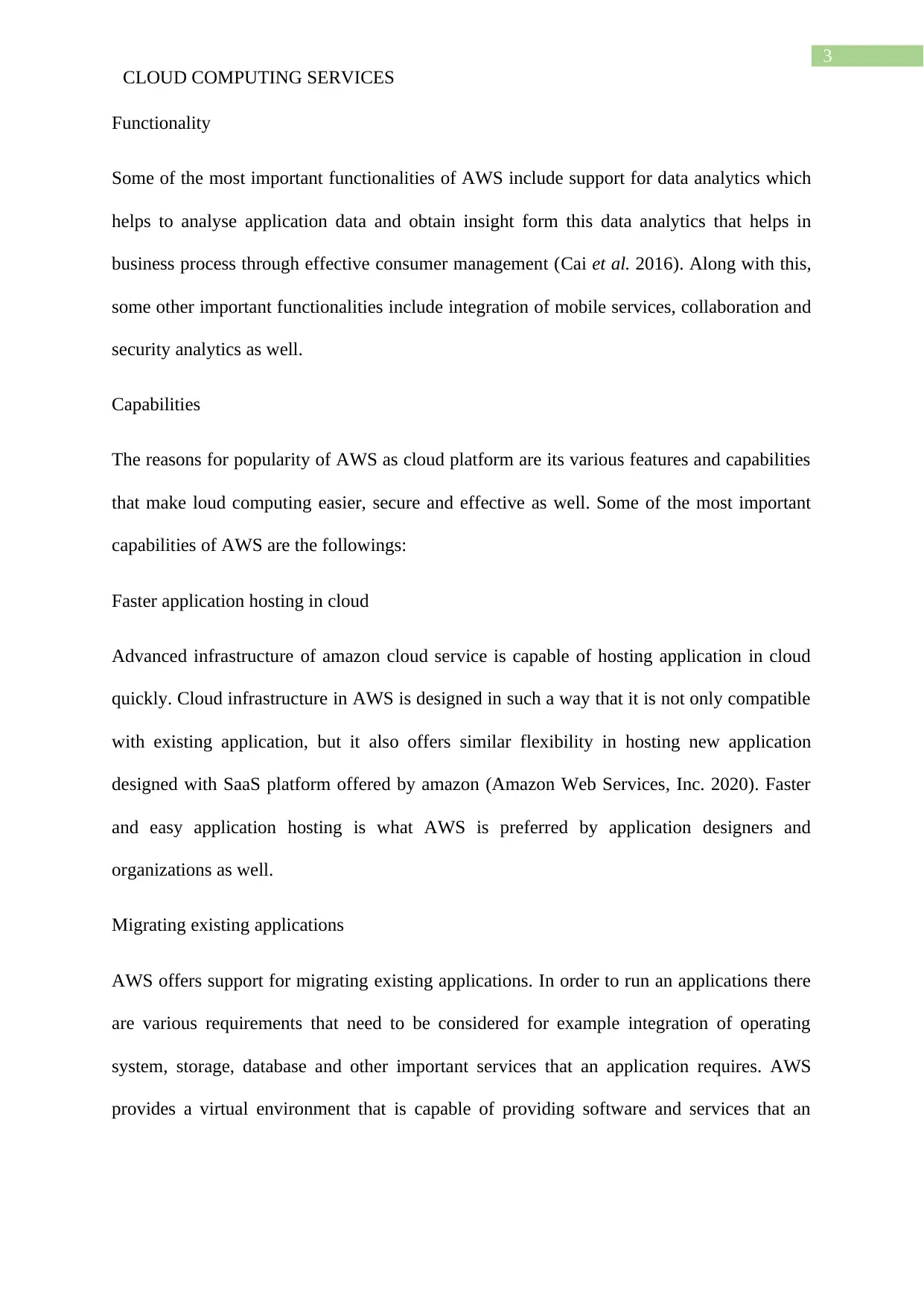
3
CLOUD COMPUTING SERVICES
Functionality
Some of the most important functionalities of AWS include support for data analytics which
helps to analyse application data and obtain insight form this data analytics that helps in
business process through effective consumer management (Cai et al. 2016). Along with this,
some other important functionalities include integration of mobile services, collaboration and
security analytics as well.
Capabilities
The reasons for popularity of AWS as cloud platform are its various features and capabilities
that make loud computing easier, secure and effective as well. Some of the most important
capabilities of AWS are the followings:
Faster application hosting in cloud
Advanced infrastructure of amazon cloud service is capable of hosting application in cloud
quickly. Cloud infrastructure in AWS is designed in such a way that it is not only compatible
with existing application, but it also offers similar flexibility in hosting new application
designed with SaaS platform offered by amazon (Amazon Web Services, Inc. 2020). Faster
and easy application hosting is what AWS is preferred by application designers and
organizations as well.
Migrating existing applications
AWS offers support for migrating existing applications. In order to run an applications there
are various requirements that need to be considered for example integration of operating
system, storage, database and other important services that an application requires. AWS
provides a virtual environment that is capable of providing software and services that an
CLOUD COMPUTING SERVICES
Functionality
Some of the most important functionalities of AWS include support for data analytics which
helps to analyse application data and obtain insight form this data analytics that helps in
business process through effective consumer management (Cai et al. 2016). Along with this,
some other important functionalities include integration of mobile services, collaboration and
security analytics as well.
Capabilities
The reasons for popularity of AWS as cloud platform are its various features and capabilities
that make loud computing easier, secure and effective as well. Some of the most important
capabilities of AWS are the followings:
Faster application hosting in cloud
Advanced infrastructure of amazon cloud service is capable of hosting application in cloud
quickly. Cloud infrastructure in AWS is designed in such a way that it is not only compatible
with existing application, but it also offers similar flexibility in hosting new application
designed with SaaS platform offered by amazon (Amazon Web Services, Inc. 2020). Faster
and easy application hosting is what AWS is preferred by application designers and
organizations as well.
Migrating existing applications
AWS offers support for migrating existing applications. In order to run an applications there
are various requirements that need to be considered for example integration of operating
system, storage, database and other important services that an application requires. AWS
provides a virtual environment that is capable of providing software and services that an
Secure Best Marks with AI Grader
Need help grading? Try our AI Grader for instant feedback on your assignments.
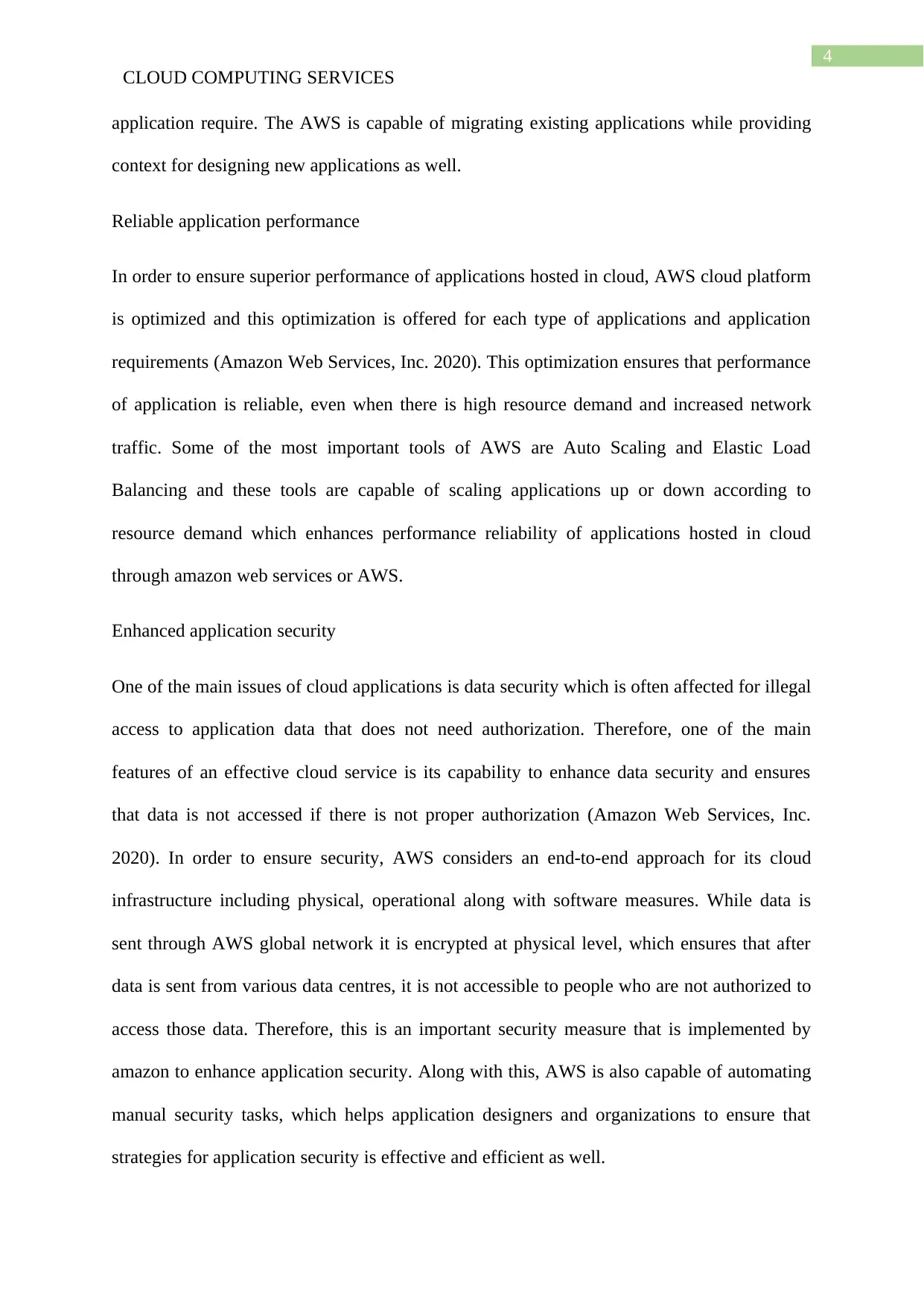
4
CLOUD COMPUTING SERVICES
application require. The AWS is capable of migrating existing applications while providing
context for designing new applications as well.
Reliable application performance
In order to ensure superior performance of applications hosted in cloud, AWS cloud platform
is optimized and this optimization is offered for each type of applications and application
requirements (Amazon Web Services, Inc. 2020). This optimization ensures that performance
of application is reliable, even when there is high resource demand and increased network
traffic. Some of the most important tools of AWS are Auto Scaling and Elastic Load
Balancing and these tools are capable of scaling applications up or down according to
resource demand which enhances performance reliability of applications hosted in cloud
through amazon web services or AWS.
Enhanced application security
One of the main issues of cloud applications is data security which is often affected for illegal
access to application data that does not need authorization. Therefore, one of the main
features of an effective cloud service is its capability to enhance data security and ensures
that data is not accessed if there is not proper authorization (Amazon Web Services, Inc.
2020). In order to ensure security, AWS considers an end-to-end approach for its cloud
infrastructure including physical, operational along with software measures. While data is
sent through AWS global network it is encrypted at physical level, which ensures that after
data is sent from various data centres, it is not accessible to people who are not authorized to
access those data. Therefore, this is an important security measure that is implemented by
amazon to enhance application security. Along with this, AWS is also capable of automating
manual security tasks, which helps application designers and organizations to ensure that
strategies for application security is effective and efficient as well.
CLOUD COMPUTING SERVICES
application require. The AWS is capable of migrating existing applications while providing
context for designing new applications as well.
Reliable application performance
In order to ensure superior performance of applications hosted in cloud, AWS cloud platform
is optimized and this optimization is offered for each type of applications and application
requirements (Amazon Web Services, Inc. 2020). This optimization ensures that performance
of application is reliable, even when there is high resource demand and increased network
traffic. Some of the most important tools of AWS are Auto Scaling and Elastic Load
Balancing and these tools are capable of scaling applications up or down according to
resource demand which enhances performance reliability of applications hosted in cloud
through amazon web services or AWS.
Enhanced application security
One of the main issues of cloud applications is data security which is often affected for illegal
access to application data that does not need authorization. Therefore, one of the main
features of an effective cloud service is its capability to enhance data security and ensures
that data is not accessed if there is not proper authorization (Amazon Web Services, Inc.
2020). In order to ensure security, AWS considers an end-to-end approach for its cloud
infrastructure including physical, operational along with software measures. While data is
sent through AWS global network it is encrypted at physical level, which ensures that after
data is sent from various data centres, it is not accessible to people who are not authorized to
access those data. Therefore, this is an important security measure that is implemented by
amazon to enhance application security. Along with this, AWS is also capable of automating
manual security tasks, which helps application designers and organizations to ensure that
strategies for application security is effective and efficient as well.
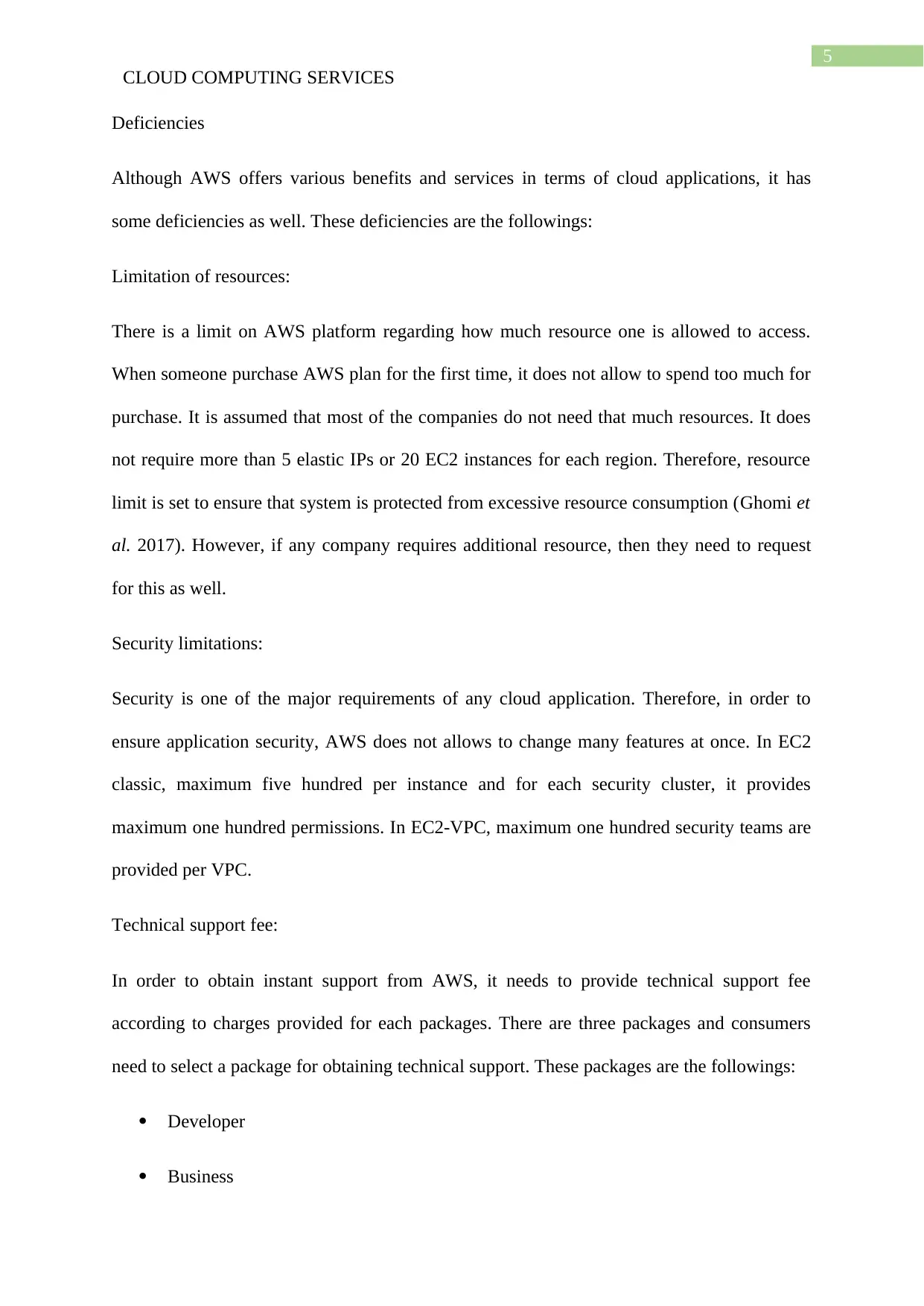
5
CLOUD COMPUTING SERVICES
Deficiencies
Although AWS offers various benefits and services in terms of cloud applications, it has
some deficiencies as well. These deficiencies are the followings:
Limitation of resources:
There is a limit on AWS platform regarding how much resource one is allowed to access.
When someone purchase AWS plan for the first time, it does not allow to spend too much for
purchase. It is assumed that most of the companies do not need that much resources. It does
not require more than 5 elastic IPs or 20 EC2 instances for each region. Therefore, resource
limit is set to ensure that system is protected from excessive resource consumption (Ghomi et
al. 2017). However, if any company requires additional resource, then they need to request
for this as well.
Security limitations:
Security is one of the major requirements of any cloud application. Therefore, in order to
ensure application security, AWS does not allows to change many features at once. In EC2
classic, maximum five hundred per instance and for each security cluster, it provides
maximum one hundred permissions. In EC2-VPC, maximum one hundred security teams are
provided per VPC.
Technical support fee:
In order to obtain instant support from AWS, it needs to provide technical support fee
according to charges provided for each packages. There are three packages and consumers
need to select a package for obtaining technical support. These packages are the followings:
Developer
Business
CLOUD COMPUTING SERVICES
Deficiencies
Although AWS offers various benefits and services in terms of cloud applications, it has
some deficiencies as well. These deficiencies are the followings:
Limitation of resources:
There is a limit on AWS platform regarding how much resource one is allowed to access.
When someone purchase AWS plan for the first time, it does not allow to spend too much for
purchase. It is assumed that most of the companies do not need that much resources. It does
not require more than 5 elastic IPs or 20 EC2 instances for each region. Therefore, resource
limit is set to ensure that system is protected from excessive resource consumption (Ghomi et
al. 2017). However, if any company requires additional resource, then they need to request
for this as well.
Security limitations:
Security is one of the major requirements of any cloud application. Therefore, in order to
ensure application security, AWS does not allows to change many features at once. In EC2
classic, maximum five hundred per instance and for each security cluster, it provides
maximum one hundred permissions. In EC2-VPC, maximum one hundred security teams are
provided per VPC.
Technical support fee:
In order to obtain instant support from AWS, it needs to provide technical support fee
according to charges provided for each packages. There are three packages and consumers
need to select a package for obtaining technical support. These packages are the followings:
Developer
Business
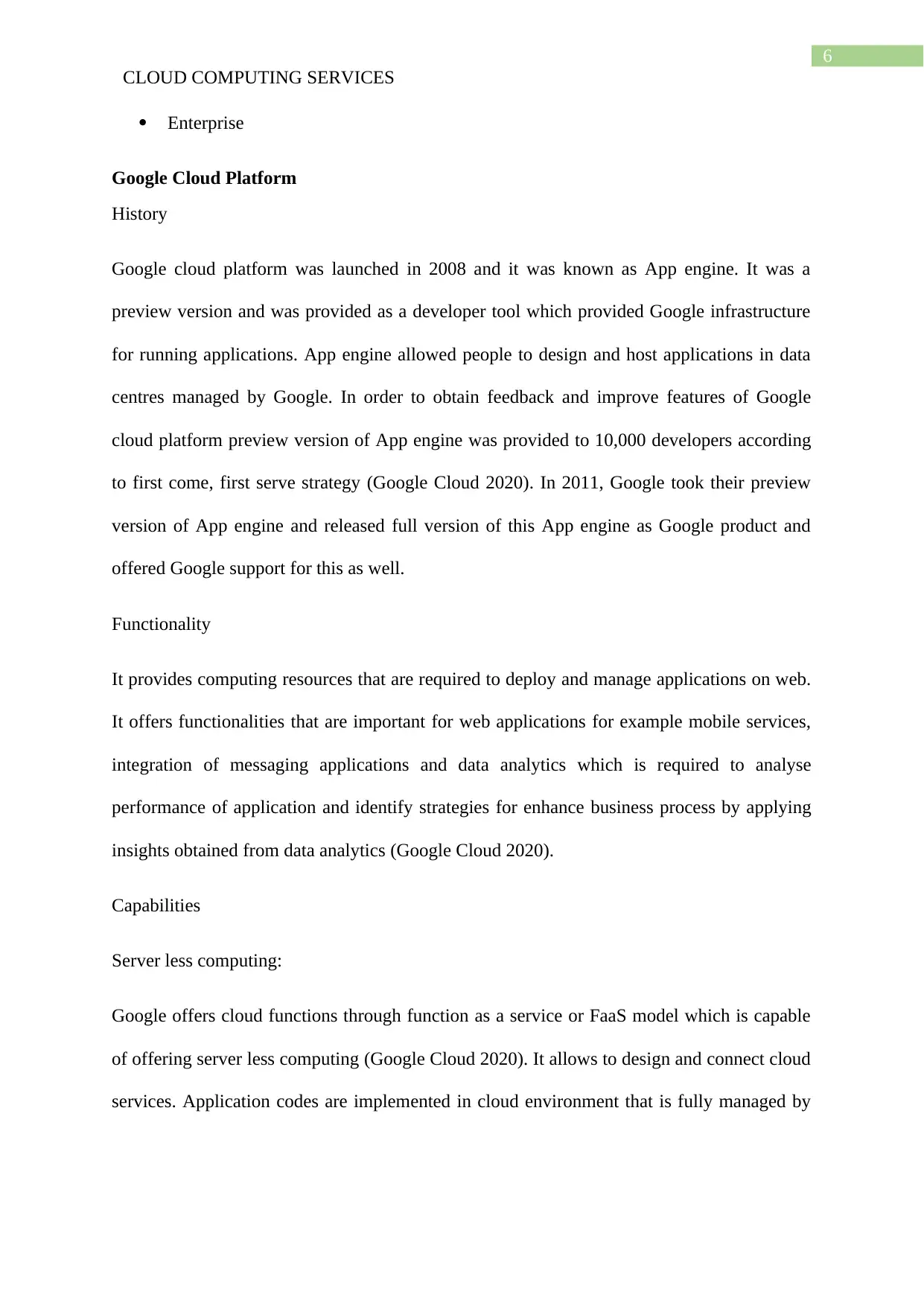
6
CLOUD COMPUTING SERVICES
Enterprise
Google Cloud Platform
History
Google cloud platform was launched in 2008 and it was known as App engine. It was a
preview version and was provided as a developer tool which provided Google infrastructure
for running applications. App engine allowed people to design and host applications in data
centres managed by Google. In order to obtain feedback and improve features of Google
cloud platform preview version of App engine was provided to 10,000 developers according
to first come, first serve strategy (Google Cloud 2020). In 2011, Google took their preview
version of App engine and released full version of this App engine as Google product and
offered Google support for this as well.
Functionality
It provides computing resources that are required to deploy and manage applications on web.
It offers functionalities that are important for web applications for example mobile services,
integration of messaging applications and data analytics which is required to analyse
performance of application and identify strategies for enhance business process by applying
insights obtained from data analytics (Google Cloud 2020).
Capabilities
Server less computing:
Google offers cloud functions through function as a service or FaaS model which is capable
of offering server less computing (Google Cloud 2020). It allows to design and connect cloud
services. Application codes are implemented in cloud environment that is fully managed by
CLOUD COMPUTING SERVICES
Enterprise
Google Cloud Platform
History
Google cloud platform was launched in 2008 and it was known as App engine. It was a
preview version and was provided as a developer tool which provided Google infrastructure
for running applications. App engine allowed people to design and host applications in data
centres managed by Google. In order to obtain feedback and improve features of Google
cloud platform preview version of App engine was provided to 10,000 developers according
to first come, first serve strategy (Google Cloud 2020). In 2011, Google took their preview
version of App engine and released full version of this App engine as Google product and
offered Google support for this as well.
Functionality
It provides computing resources that are required to deploy and manage applications on web.
It offers functionalities that are important for web applications for example mobile services,
integration of messaging applications and data analytics which is required to analyse
performance of application and identify strategies for enhance business process by applying
insights obtained from data analytics (Google Cloud 2020).
Capabilities
Server less computing:
Google offers cloud functions through function as a service or FaaS model which is capable
of offering server less computing (Google Cloud 2020). It allows to design and connect cloud
services. Application codes are implemented in cloud environment that is fully managed by
Paraphrase This Document
Need a fresh take? Get an instant paraphrase of this document with our AI Paraphraser
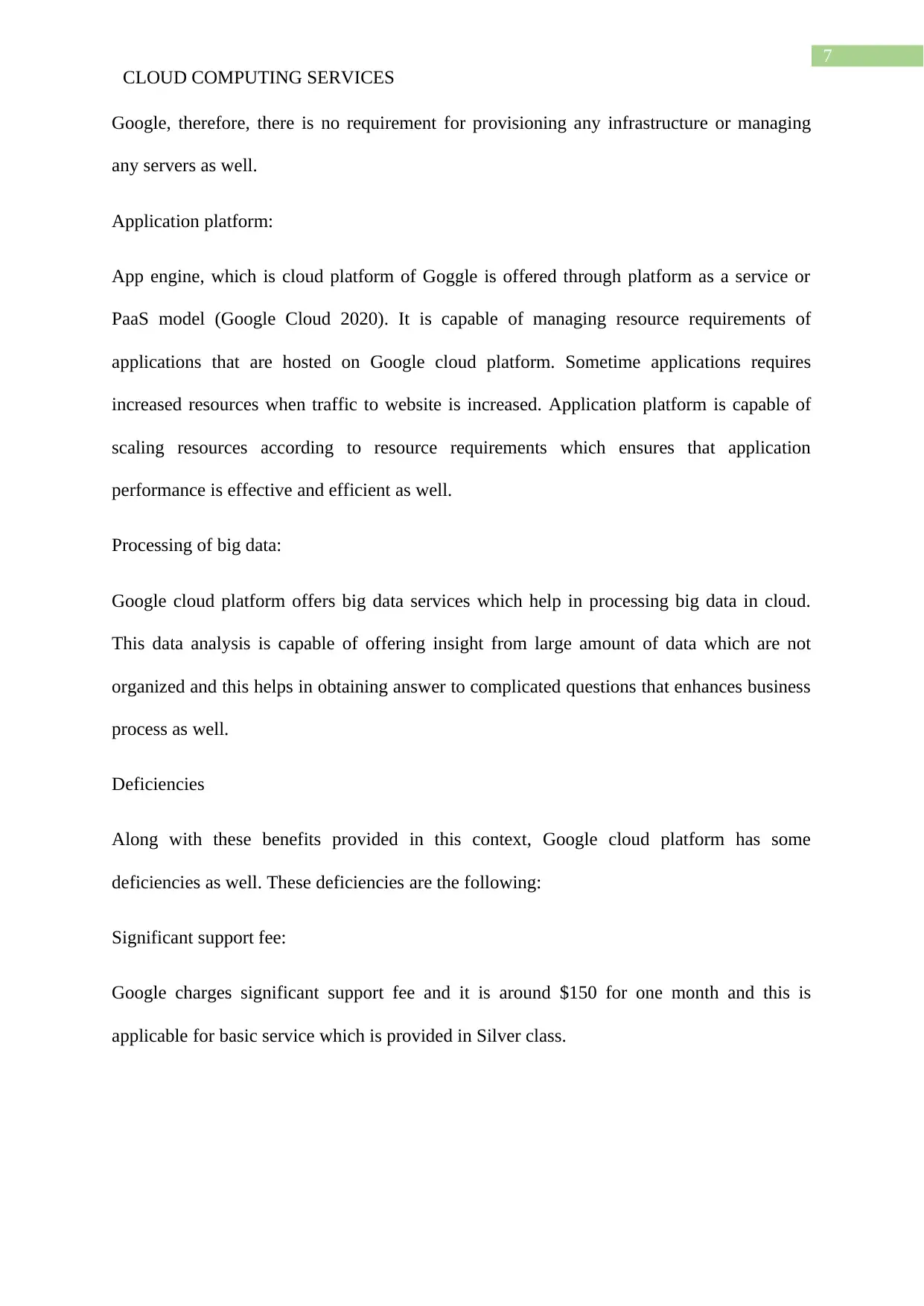
7
CLOUD COMPUTING SERVICES
Google, therefore, there is no requirement for provisioning any infrastructure or managing
any servers as well.
Application platform:
App engine, which is cloud platform of Goggle is offered through platform as a service or
PaaS model (Google Cloud 2020). It is capable of managing resource requirements of
applications that are hosted on Google cloud platform. Sometime applications requires
increased resources when traffic to website is increased. Application platform is capable of
scaling resources according to resource requirements which ensures that application
performance is effective and efficient as well.
Processing of big data:
Google cloud platform offers big data services which help in processing big data in cloud.
This data analysis is capable of offering insight from large amount of data which are not
organized and this helps in obtaining answer to complicated questions that enhances business
process as well.
Deficiencies
Along with these benefits provided in this context, Google cloud platform has some
deficiencies as well. These deficiencies are the following:
Significant support fee:
Google charges significant support fee and it is around $150 for one month and this is
applicable for basic service which is provided in Silver class.
CLOUD COMPUTING SERVICES
Google, therefore, there is no requirement for provisioning any infrastructure or managing
any servers as well.
Application platform:
App engine, which is cloud platform of Goggle is offered through platform as a service or
PaaS model (Google Cloud 2020). It is capable of managing resource requirements of
applications that are hosted on Google cloud platform. Sometime applications requires
increased resources when traffic to website is increased. Application platform is capable of
scaling resources according to resource requirements which ensures that application
performance is effective and efficient as well.
Processing of big data:
Google cloud platform offers big data services which help in processing big data in cloud.
This data analysis is capable of offering insight from large amount of data which are not
organized and this helps in obtaining answer to complicated questions that enhances business
process as well.
Deficiencies
Along with these benefits provided in this context, Google cloud platform has some
deficiencies as well. These deficiencies are the following:
Significant support fee:
Google charges significant support fee and it is around $150 for one month and this is
applicable for basic service which is provided in Silver class.
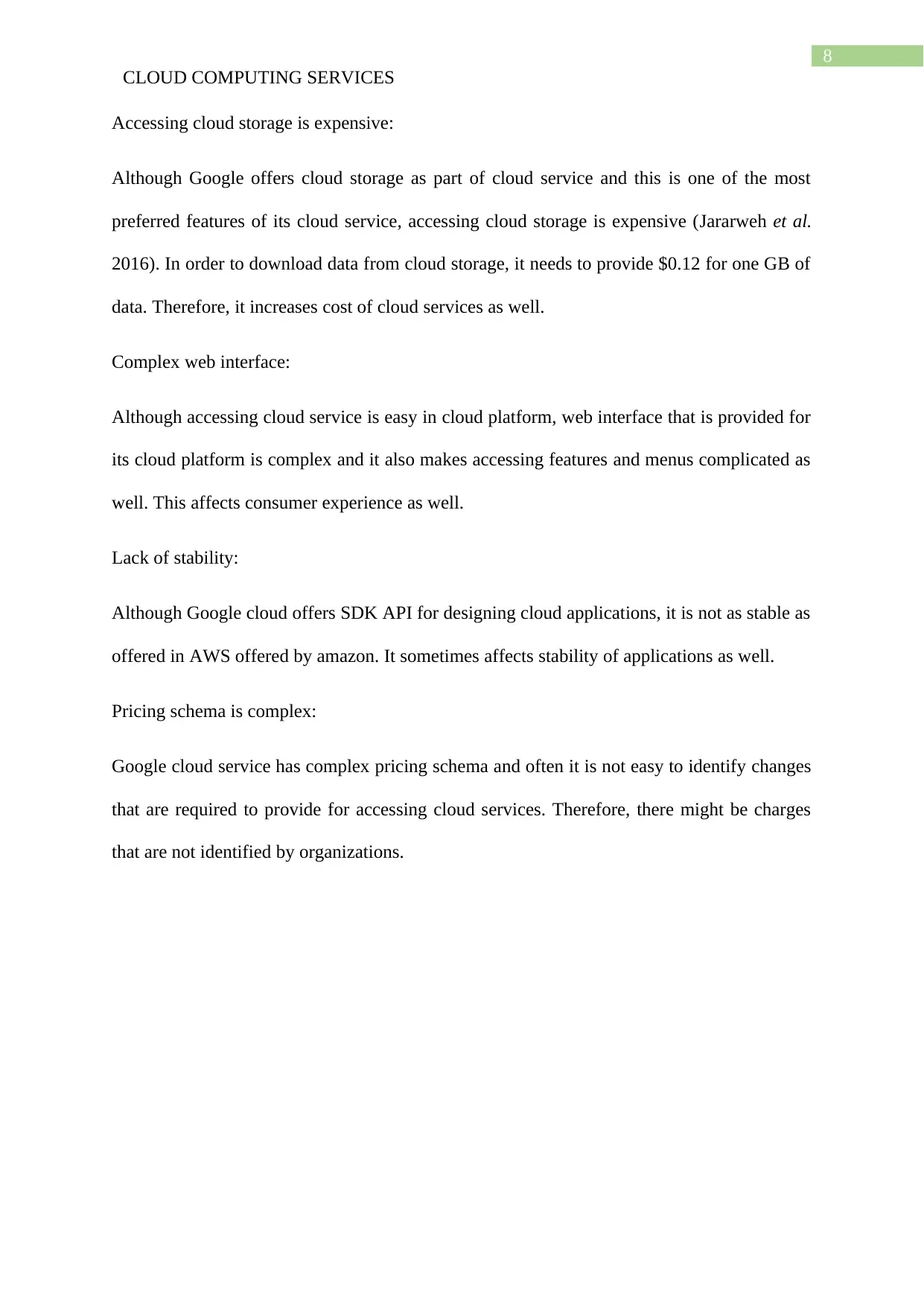
8
CLOUD COMPUTING SERVICES
Accessing cloud storage is expensive:
Although Google offers cloud storage as part of cloud service and this is one of the most
preferred features of its cloud service, accessing cloud storage is expensive (Jararweh et al.
2016). In order to download data from cloud storage, it needs to provide $0.12 for one GB of
data. Therefore, it increases cost of cloud services as well.
Complex web interface:
Although accessing cloud service is easy in cloud platform, web interface that is provided for
its cloud platform is complex and it also makes accessing features and menus complicated as
well. This affects consumer experience as well.
Lack of stability:
Although Google cloud offers SDK API for designing cloud applications, it is not as stable as
offered in AWS offered by amazon. It sometimes affects stability of applications as well.
Pricing schema is complex:
Google cloud service has complex pricing schema and often it is not easy to identify changes
that are required to provide for accessing cloud services. Therefore, there might be charges
that are not identified by organizations.
CLOUD COMPUTING SERVICES
Accessing cloud storage is expensive:
Although Google offers cloud storage as part of cloud service and this is one of the most
preferred features of its cloud service, accessing cloud storage is expensive (Jararweh et al.
2016). In order to download data from cloud storage, it needs to provide $0.12 for one GB of
data. Therefore, it increases cost of cloud services as well.
Complex web interface:
Although accessing cloud service is easy in cloud platform, web interface that is provided for
its cloud platform is complex and it also makes accessing features and menus complicated as
well. This affects consumer experience as well.
Lack of stability:
Although Google cloud offers SDK API for designing cloud applications, it is not as stable as
offered in AWS offered by amazon. It sometimes affects stability of applications as well.
Pricing schema is complex:
Google cloud service has complex pricing schema and often it is not easy to identify changes
that are required to provide for accessing cloud services. Therefore, there might be charges
that are not identified by organizations.
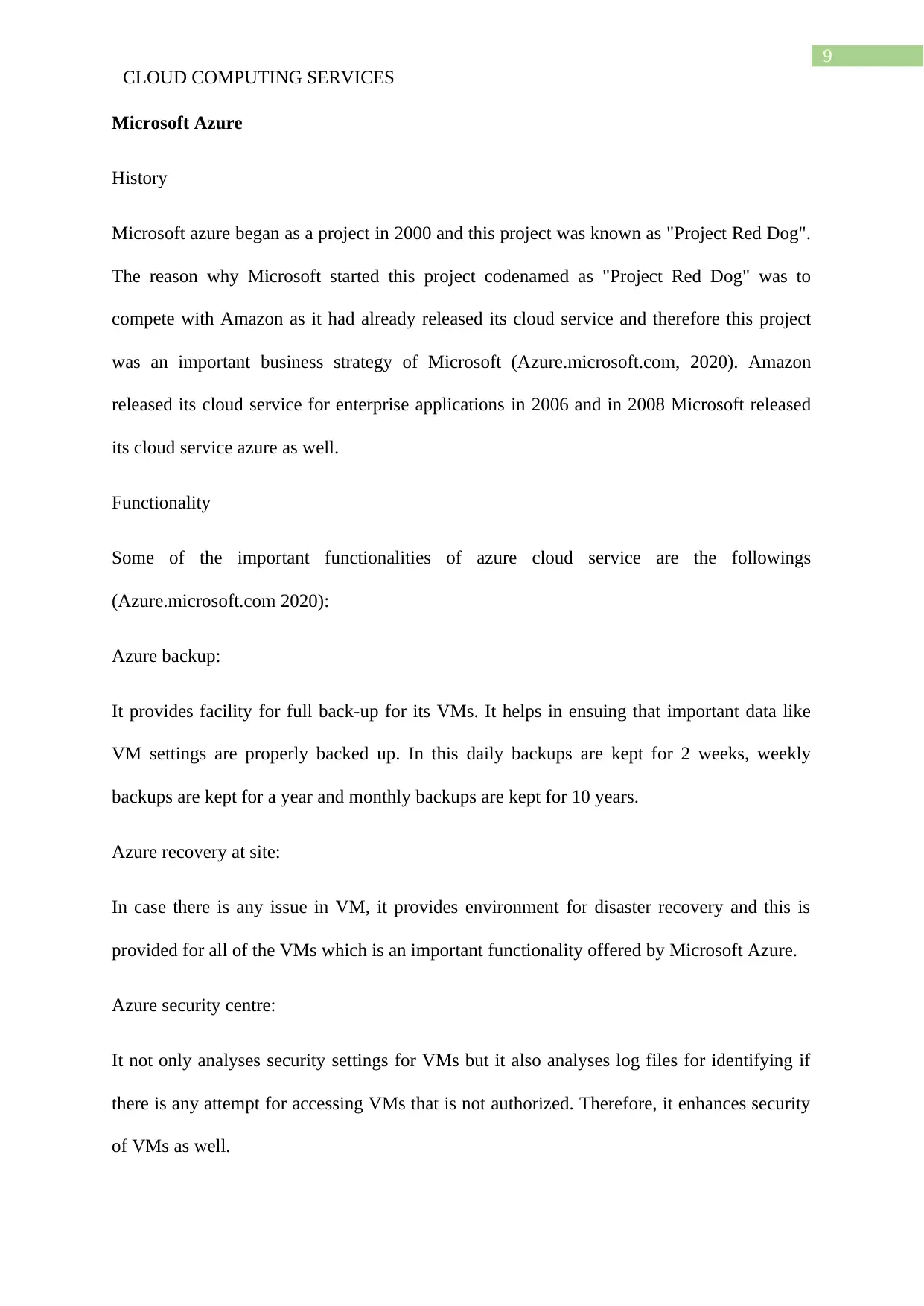
9
CLOUD COMPUTING SERVICES
Microsoft Azure
History
Microsoft azure began as a project in 2000 and this project was known as "Project Red Dog".
The reason why Microsoft started this project codenamed as "Project Red Dog" was to
compete with Amazon as it had already released its cloud service and therefore this project
was an important business strategy of Microsoft (Azure.microsoft.com, 2020). Amazon
released its cloud service for enterprise applications in 2006 and in 2008 Microsoft released
its cloud service azure as well.
Functionality
Some of the important functionalities of azure cloud service are the followings
(Azure.microsoft.com 2020):
Azure backup:
It provides facility for full back-up for its VMs. It helps in ensuing that important data like
VM settings are properly backed up. In this daily backups are kept for 2 weeks, weekly
backups are kept for a year and monthly backups are kept for 10 years.
Azure recovery at site:
In case there is any issue in VM, it provides environment for disaster recovery and this is
provided for all of the VMs which is an important functionality offered by Microsoft Azure.
Azure security centre:
It not only analyses security settings for VMs but it also analyses log files for identifying if
there is any attempt for accessing VMs that is not authorized. Therefore, it enhances security
of VMs as well.
CLOUD COMPUTING SERVICES
Microsoft Azure
History
Microsoft azure began as a project in 2000 and this project was known as "Project Red Dog".
The reason why Microsoft started this project codenamed as "Project Red Dog" was to
compete with Amazon as it had already released its cloud service and therefore this project
was an important business strategy of Microsoft (Azure.microsoft.com, 2020). Amazon
released its cloud service for enterprise applications in 2006 and in 2008 Microsoft released
its cloud service azure as well.
Functionality
Some of the important functionalities of azure cloud service are the followings
(Azure.microsoft.com 2020):
Azure backup:
It provides facility for full back-up for its VMs. It helps in ensuing that important data like
VM settings are properly backed up. In this daily backups are kept for 2 weeks, weekly
backups are kept for a year and monthly backups are kept for 10 years.
Azure recovery at site:
In case there is any issue in VM, it provides environment for disaster recovery and this is
provided for all of the VMs which is an important functionality offered by Microsoft Azure.
Azure security centre:
It not only analyses security settings for VMs but it also analyses log files for identifying if
there is any attempt for accessing VMs that is not authorized. Therefore, it enhances security
of VMs as well.
Secure Best Marks with AI Grader
Need help grading? Try our AI Grader for instant feedback on your assignments.
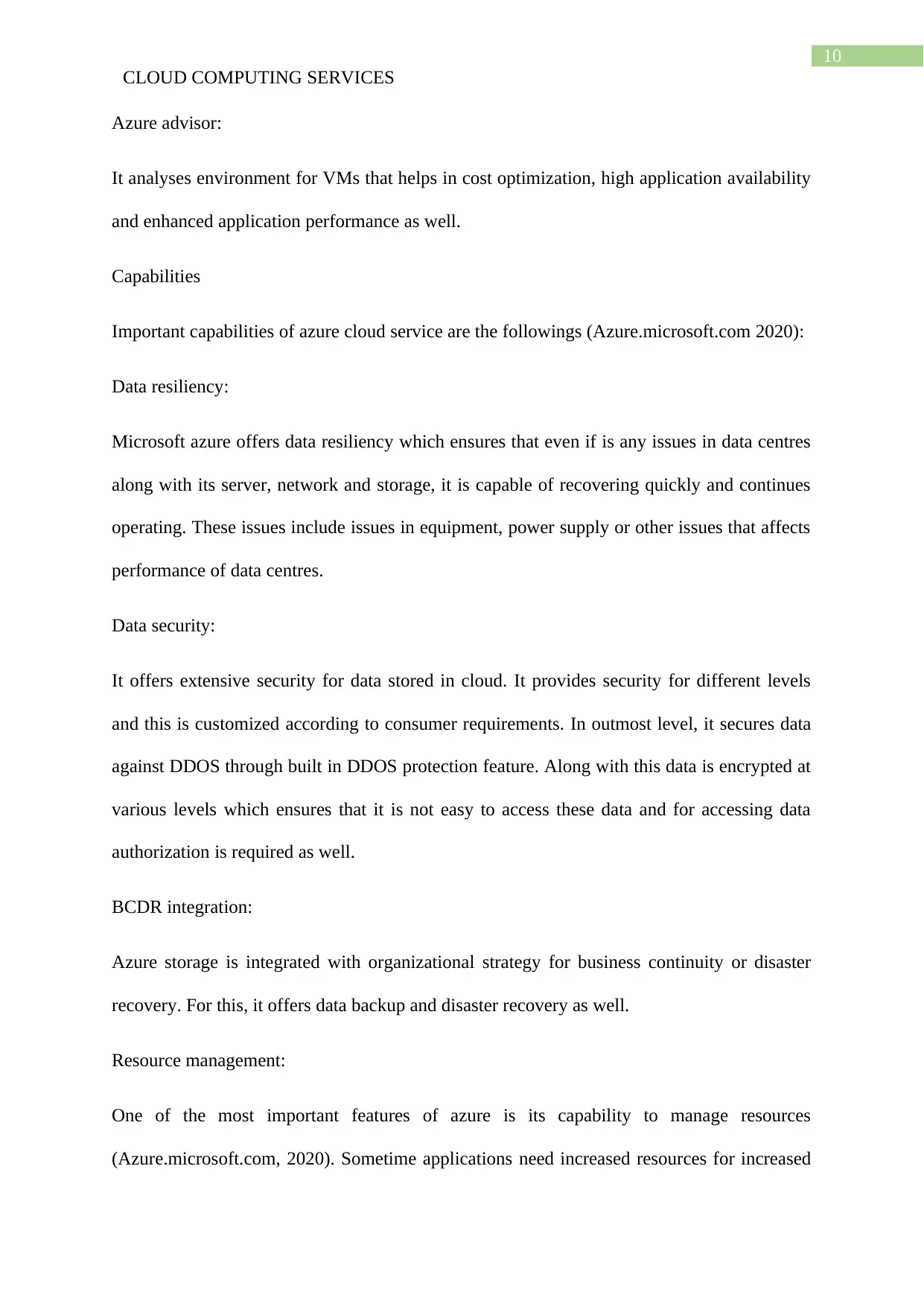
10
CLOUD COMPUTING SERVICES
Azure advisor:
It analyses environment for VMs that helps in cost optimization, high application availability
and enhanced application performance as well.
Capabilities
Important capabilities of azure cloud service are the followings (Azure.microsoft.com 2020):
Data resiliency:
Microsoft azure offers data resiliency which ensures that even if is any issues in data centres
along with its server, network and storage, it is capable of recovering quickly and continues
operating. These issues include issues in equipment, power supply or other issues that affects
performance of data centres.
Data security:
It offers extensive security for data stored in cloud. It provides security for different levels
and this is customized according to consumer requirements. In outmost level, it secures data
against DDOS through built in DDOS protection feature. Along with this data is encrypted at
various levels which ensures that it is not easy to access these data and for accessing data
authorization is required as well.
BCDR integration:
Azure storage is integrated with organizational strategy for business continuity or disaster
recovery. For this, it offers data backup and disaster recovery as well.
Resource management:
One of the most important features of azure is its capability to manage resources
(Azure.microsoft.com, 2020). Sometime applications need increased resources for increased
CLOUD COMPUTING SERVICES
Azure advisor:
It analyses environment for VMs that helps in cost optimization, high application availability
and enhanced application performance as well.
Capabilities
Important capabilities of azure cloud service are the followings (Azure.microsoft.com 2020):
Data resiliency:
Microsoft azure offers data resiliency which ensures that even if is any issues in data centres
along with its server, network and storage, it is capable of recovering quickly and continues
operating. These issues include issues in equipment, power supply or other issues that affects
performance of data centres.
Data security:
It offers extensive security for data stored in cloud. It provides security for different levels
and this is customized according to consumer requirements. In outmost level, it secures data
against DDOS through built in DDOS protection feature. Along with this data is encrypted at
various levels which ensures that it is not easy to access these data and for accessing data
authorization is required as well.
BCDR integration:
Azure storage is integrated with organizational strategy for business continuity or disaster
recovery. For this, it offers data backup and disaster recovery as well.
Resource management:
One of the most important features of azure is its capability to manage resources
(Azure.microsoft.com, 2020). Sometime applications need increased resources for increased
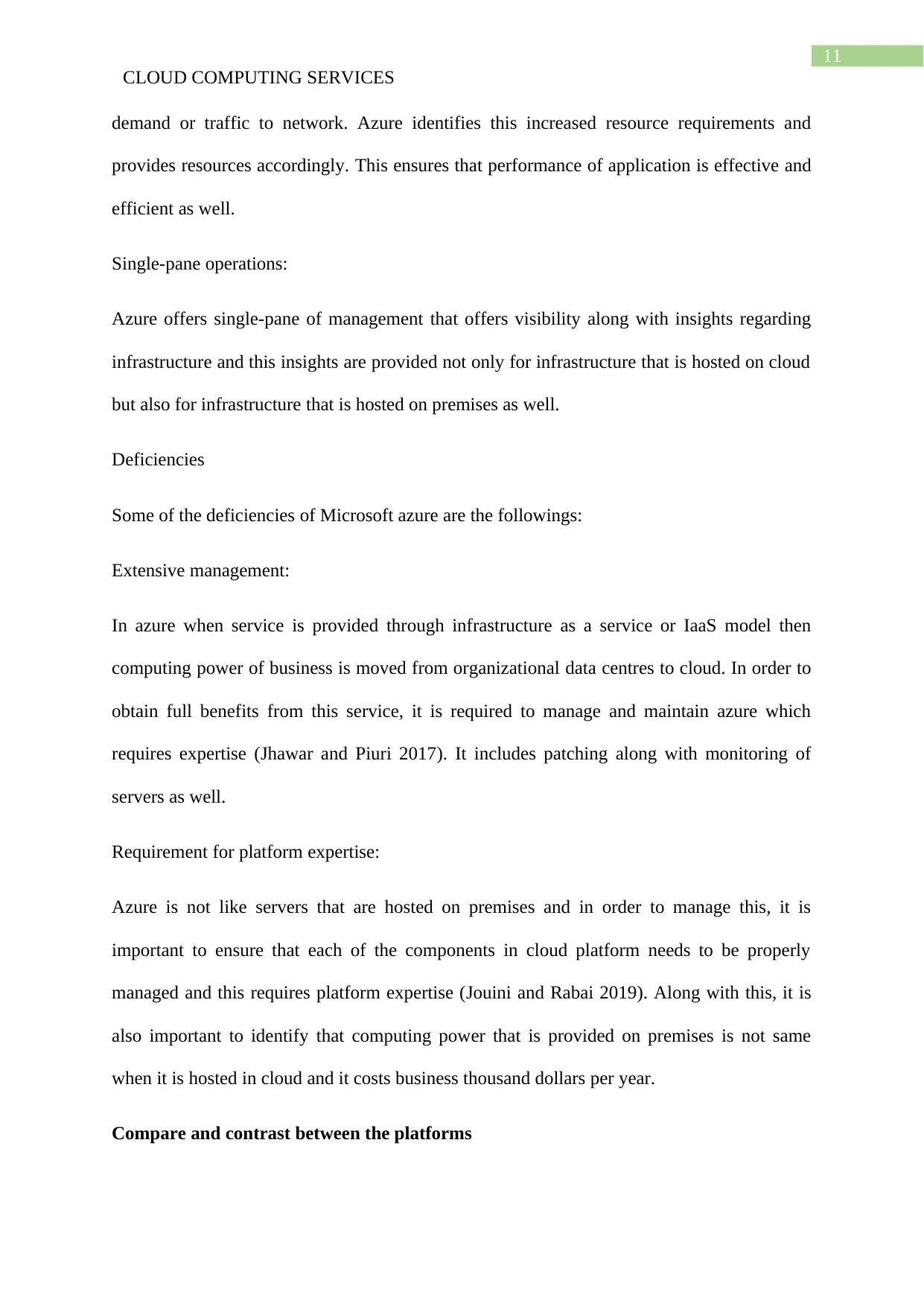
11
CLOUD COMPUTING SERVICES
demand or traffic to network. Azure identifies this increased resource requirements and
provides resources accordingly. This ensures that performance of application is effective and
efficient as well.
Single-pane operations:
Azure offers single-pane of management that offers visibility along with insights regarding
infrastructure and this insights are provided not only for infrastructure that is hosted on cloud
but also for infrastructure that is hosted on premises as well.
Deficiencies
Some of the deficiencies of Microsoft azure are the followings:
Extensive management:
In azure when service is provided through infrastructure as a service or IaaS model then
computing power of business is moved from organizational data centres to cloud. In order to
obtain full benefits from this service, it is required to manage and maintain azure which
requires expertise (Jhawar and Piuri 2017). It includes patching along with monitoring of
servers as well.
Requirement for platform expertise:
Azure is not like servers that are hosted on premises and in order to manage this, it is
important to ensure that each of the components in cloud platform needs to be properly
managed and this requires platform expertise (Jouini and Rabai 2019). Along with this, it is
also important to identify that computing power that is provided on premises is not same
when it is hosted in cloud and it costs business thousand dollars per year.
Compare and contrast between the platforms
CLOUD COMPUTING SERVICES
demand or traffic to network. Azure identifies this increased resource requirements and
provides resources accordingly. This ensures that performance of application is effective and
efficient as well.
Single-pane operations:
Azure offers single-pane of management that offers visibility along with insights regarding
infrastructure and this insights are provided not only for infrastructure that is hosted on cloud
but also for infrastructure that is hosted on premises as well.
Deficiencies
Some of the deficiencies of Microsoft azure are the followings:
Extensive management:
In azure when service is provided through infrastructure as a service or IaaS model then
computing power of business is moved from organizational data centres to cloud. In order to
obtain full benefits from this service, it is required to manage and maintain azure which
requires expertise (Jhawar and Piuri 2017). It includes patching along with monitoring of
servers as well.
Requirement for platform expertise:
Azure is not like servers that are hosted on premises and in order to manage this, it is
important to ensure that each of the components in cloud platform needs to be properly
managed and this requires platform expertise (Jouini and Rabai 2019). Along with this, it is
also important to identify that computing power that is provided on premises is not same
when it is hosted in cloud and it costs business thousand dollars per year.
Compare and contrast between the platforms
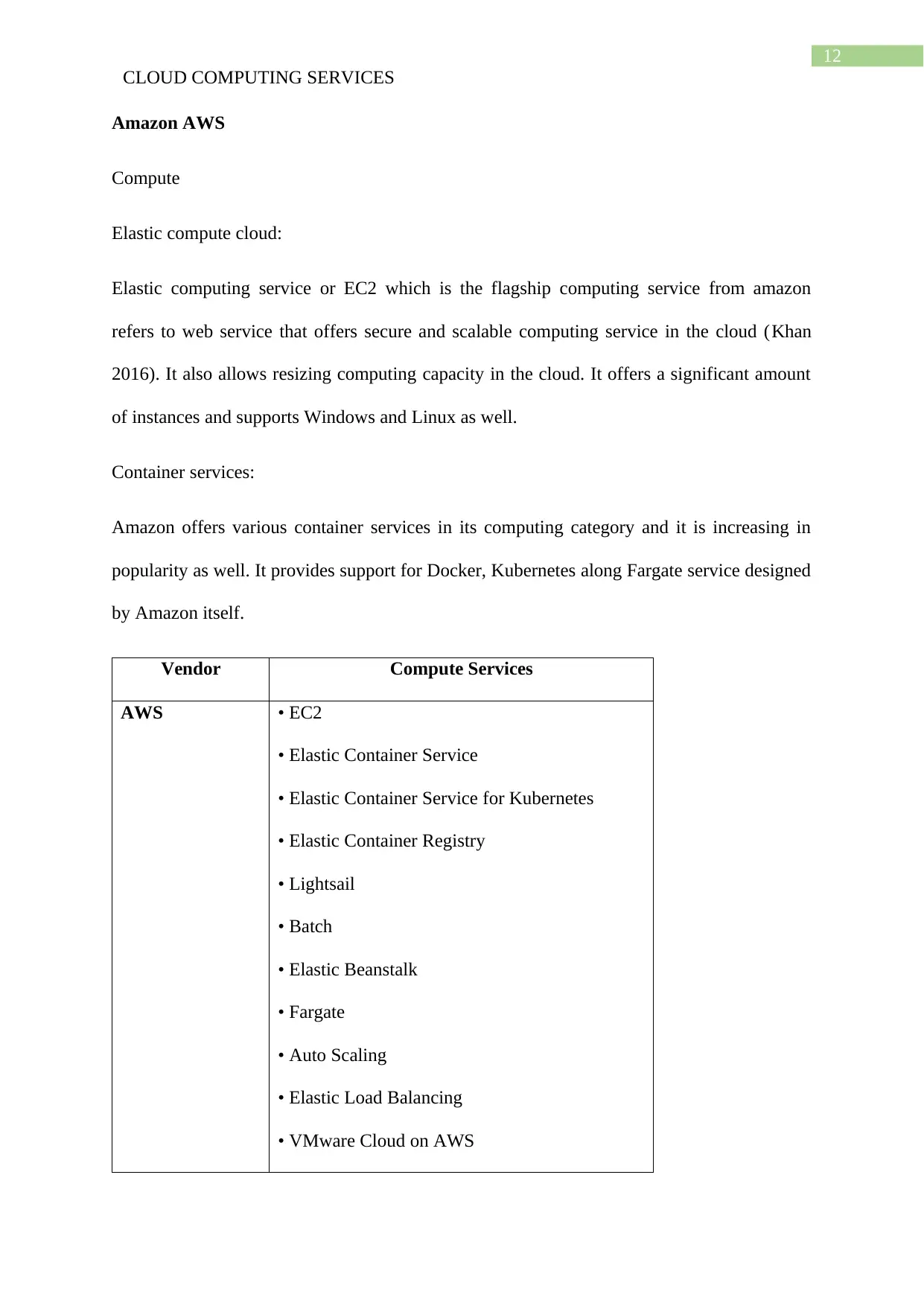
12
CLOUD COMPUTING SERVICES
Amazon AWS
Compute
Elastic compute cloud:
Elastic computing service or EC2 which is the flagship computing service from amazon
refers to web service that offers secure and scalable computing service in the cloud (Khan
2016). It also allows resizing computing capacity in the cloud. It offers a significant amount
of instances and supports Windows and Linux as well.
Container services:
Amazon offers various container services in its computing category and it is increasing in
popularity as well. It provides support for Docker, Kubernetes along Fargate service designed
by Amazon itself.
Vendor Compute Services
AWS • EC2
• Elastic Container Service
• Elastic Container Service for Kubernetes
• Elastic Container Registry
• Lightsail
• Batch
• Elastic Beanstalk
• Fargate
• Auto Scaling
• Elastic Load Balancing
• VMware Cloud on AWS
CLOUD COMPUTING SERVICES
Amazon AWS
Compute
Elastic compute cloud:
Elastic computing service or EC2 which is the flagship computing service from amazon
refers to web service that offers secure and scalable computing service in the cloud (Khan
2016). It also allows resizing computing capacity in the cloud. It offers a significant amount
of instances and supports Windows and Linux as well.
Container services:
Amazon offers various container services in its computing category and it is increasing in
popularity as well. It provides support for Docker, Kubernetes along Fargate service designed
by Amazon itself.
Vendor Compute Services
AWS • EC2
• Elastic Container Service
• Elastic Container Service for Kubernetes
• Elastic Container Registry
• Lightsail
• Batch
• Elastic Beanstalk
• Fargate
• Auto Scaling
• Elastic Load Balancing
• VMware Cloud on AWS
Paraphrase This Document
Need a fresh take? Get an instant paraphrase of this document with our AI Paraphraser
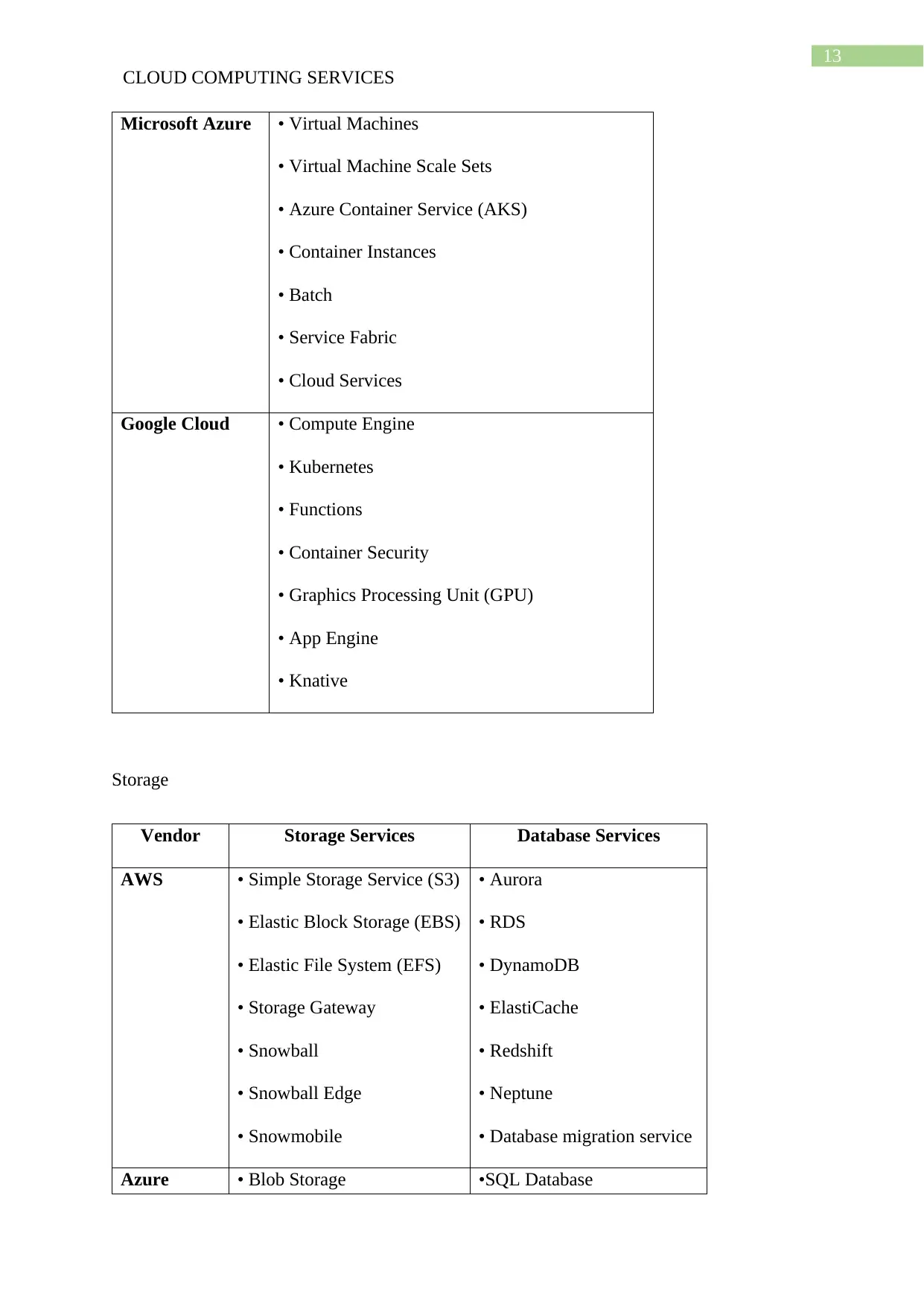
13
CLOUD COMPUTING SERVICES
Microsoft Azure • Virtual Machines
• Virtual Machine Scale Sets
• Azure Container Service (AKS)
• Container Instances
• Batch
• Service Fabric
• Cloud Services
Google Cloud • Compute Engine
• Kubernetes
• Functions
• Container Security
• Graphics Processing Unit (GPU)
• App Engine
• Knative
Storage
Vendor Storage Services Database Services
AWS • Simple Storage Service (S3)
• Elastic Block Storage (EBS)
• Elastic File System (EFS)
• Storage Gateway
• Snowball
• Snowball Edge
• Snowmobile
• Aurora
• RDS
• DynamoDB
• ElastiCache
• Redshift
• Neptune
• Database migration service
Azure • Blob Storage •SQL Database
CLOUD COMPUTING SERVICES
Microsoft Azure • Virtual Machines
• Virtual Machine Scale Sets
• Azure Container Service (AKS)
• Container Instances
• Batch
• Service Fabric
• Cloud Services
Google Cloud • Compute Engine
• Kubernetes
• Functions
• Container Security
• Graphics Processing Unit (GPU)
• App Engine
• Knative
Storage
Vendor Storage Services Database Services
AWS • Simple Storage Service (S3)
• Elastic Block Storage (EBS)
• Elastic File System (EFS)
• Storage Gateway
• Snowball
• Snowball Edge
• Snowmobile
• Aurora
• RDS
• DynamoDB
• ElastiCache
• Redshift
• Neptune
• Database migration service
Azure • Blob Storage •SQL Database
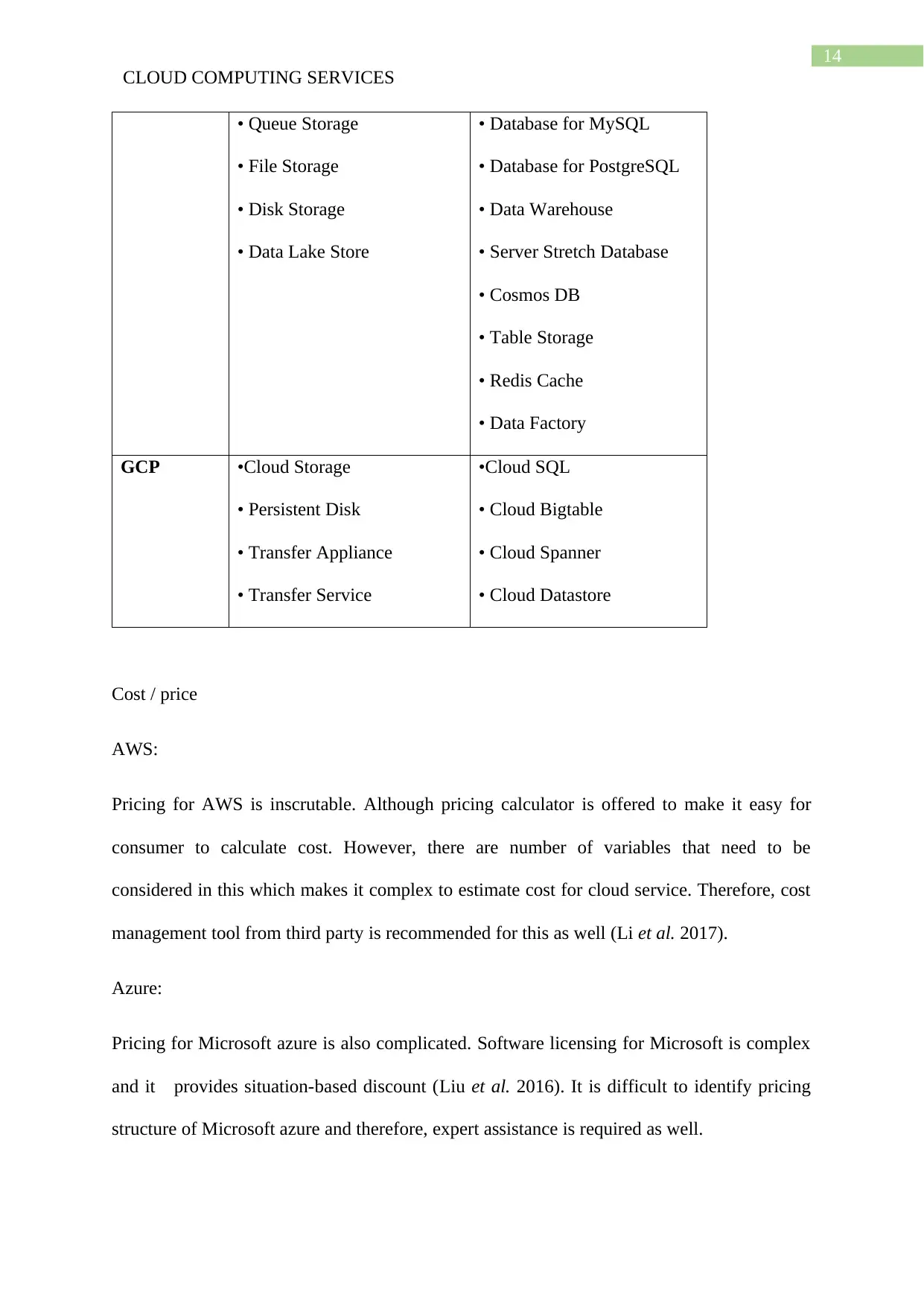
14
CLOUD COMPUTING SERVICES
• Queue Storage
• File Storage
• Disk Storage
• Data Lake Store
• Database for MySQL
• Database for PostgreSQL
• Data Warehouse
• Server Stretch Database
• Cosmos DB
• Table Storage
• Redis Cache
• Data Factory
GCP •Cloud Storage
• Persistent Disk
• Transfer Appliance
• Transfer Service
•Cloud SQL
• Cloud Bigtable
• Cloud Spanner
• Cloud Datastore
Cost / price
AWS:
Pricing for AWS is inscrutable. Although pricing calculator is offered to make it easy for
consumer to calculate cost. However, there are number of variables that need to be
considered in this which makes it complex to estimate cost for cloud service. Therefore, cost
management tool from third party is recommended for this as well (Li et al. 2017).
Azure:
Pricing for Microsoft azure is also complicated. Software licensing for Microsoft is complex
and it provides situation-based discount (Liu et al. 2016). It is difficult to identify pricing
structure of Microsoft azure and therefore, expert assistance is required as well.
CLOUD COMPUTING SERVICES
• Queue Storage
• File Storage
• Disk Storage
• Data Lake Store
• Database for MySQL
• Database for PostgreSQL
• Data Warehouse
• Server Stretch Database
• Cosmos DB
• Table Storage
• Redis Cache
• Data Factory
GCP •Cloud Storage
• Persistent Disk
• Transfer Appliance
• Transfer Service
•Cloud SQL
• Cloud Bigtable
• Cloud Spanner
• Cloud Datastore
Cost / price
AWS:
Pricing for AWS is inscrutable. Although pricing calculator is offered to make it easy for
consumer to calculate cost. However, there are number of variables that need to be
considered in this which makes it complex to estimate cost for cloud service. Therefore, cost
management tool from third party is recommended for this as well (Li et al. 2017).
Azure:
Pricing for Microsoft azure is also complicated. Software licensing for Microsoft is complex
and it provides situation-based discount (Liu et al. 2016). It is difficult to identify pricing
structure of Microsoft azure and therefore, expert assistance is required as well.
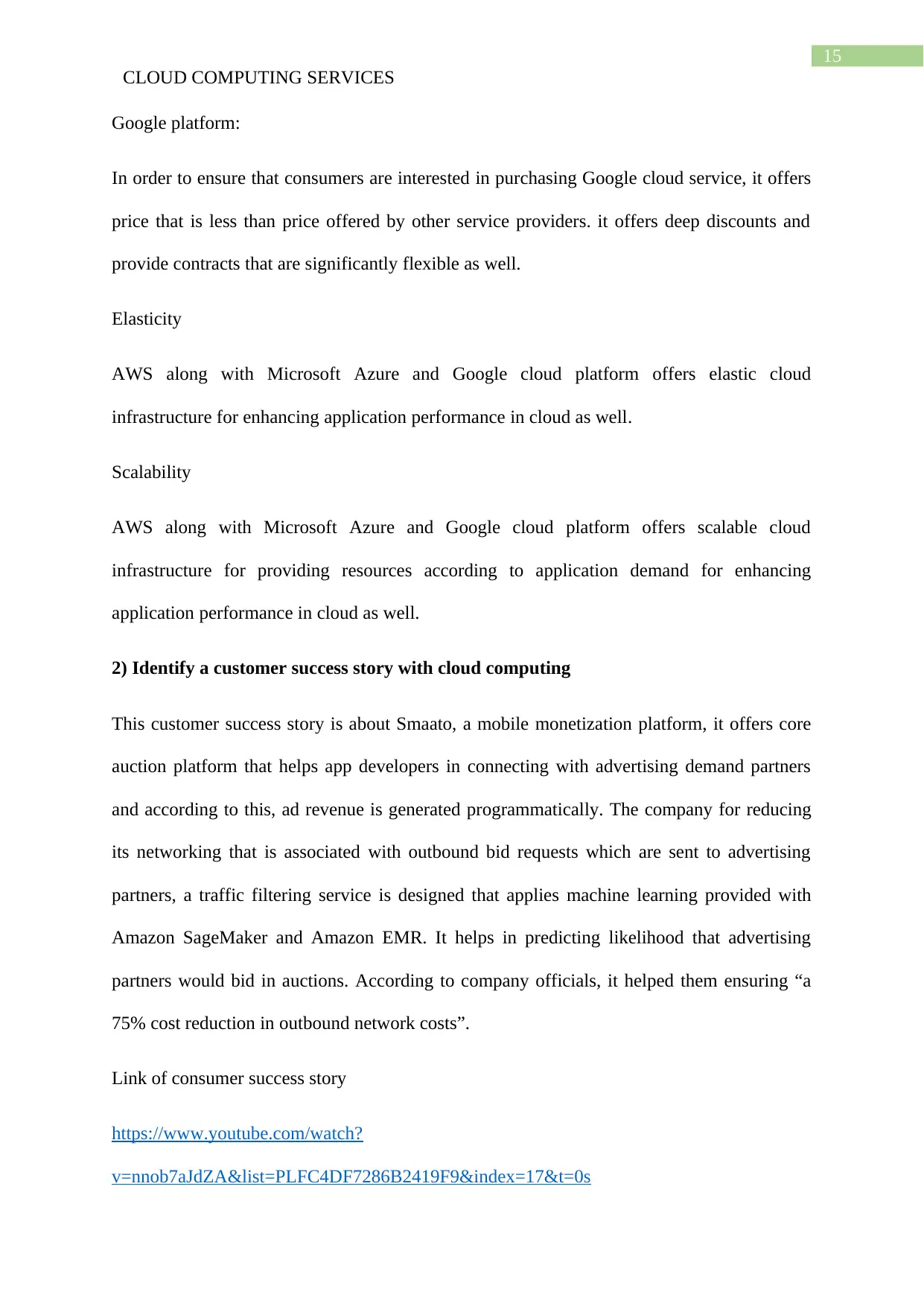
15
CLOUD COMPUTING SERVICES
Google platform:
In order to ensure that consumers are interested in purchasing Google cloud service, it offers
price that is less than price offered by other service providers. it offers deep discounts and
provide contracts that are significantly flexible as well.
Elasticity
AWS along with Microsoft Azure and Google cloud platform offers elastic cloud
infrastructure for enhancing application performance in cloud as well.
Scalability
AWS along with Microsoft Azure and Google cloud platform offers scalable cloud
infrastructure for providing resources according to application demand for enhancing
application performance in cloud as well.
2) Identify a customer success story with cloud computing
This customer success story is about Smaato, a mobile monetization platform, it offers core
auction platform that helps app developers in connecting with advertising demand partners
and according to this, ad revenue is generated programmatically. The company for reducing
its networking that is associated with outbound bid requests which are sent to advertising
partners, a traffic filtering service is designed that applies machine learning provided with
Amazon SageMaker and Amazon EMR. It helps in predicting likelihood that advertising
partners would bid in auctions. According to company officials, it helped them ensuring “a
75% cost reduction in outbound network costs”.
Link of consumer success story
https://www.youtube.com/watch?
v=nnob7aJdZA&list=PLFC4DF7286B2419F9&index=17&t=0s
CLOUD COMPUTING SERVICES
Google platform:
In order to ensure that consumers are interested in purchasing Google cloud service, it offers
price that is less than price offered by other service providers. it offers deep discounts and
provide contracts that are significantly flexible as well.
Elasticity
AWS along with Microsoft Azure and Google cloud platform offers elastic cloud
infrastructure for enhancing application performance in cloud as well.
Scalability
AWS along with Microsoft Azure and Google cloud platform offers scalable cloud
infrastructure for providing resources according to application demand for enhancing
application performance in cloud as well.
2) Identify a customer success story with cloud computing
This customer success story is about Smaato, a mobile monetization platform, it offers core
auction platform that helps app developers in connecting with advertising demand partners
and according to this, ad revenue is generated programmatically. The company for reducing
its networking that is associated with outbound bid requests which are sent to advertising
partners, a traffic filtering service is designed that applies machine learning provided with
Amazon SageMaker and Amazon EMR. It helps in predicting likelihood that advertising
partners would bid in auctions. According to company officials, it helped them ensuring “a
75% cost reduction in outbound network costs”.
Link of consumer success story
https://www.youtube.com/watch?
v=nnob7aJdZA&list=PLFC4DF7286B2419F9&index=17&t=0s
Secure Best Marks with AI Grader
Need help grading? Try our AI Grader for instant feedback on your assignments.
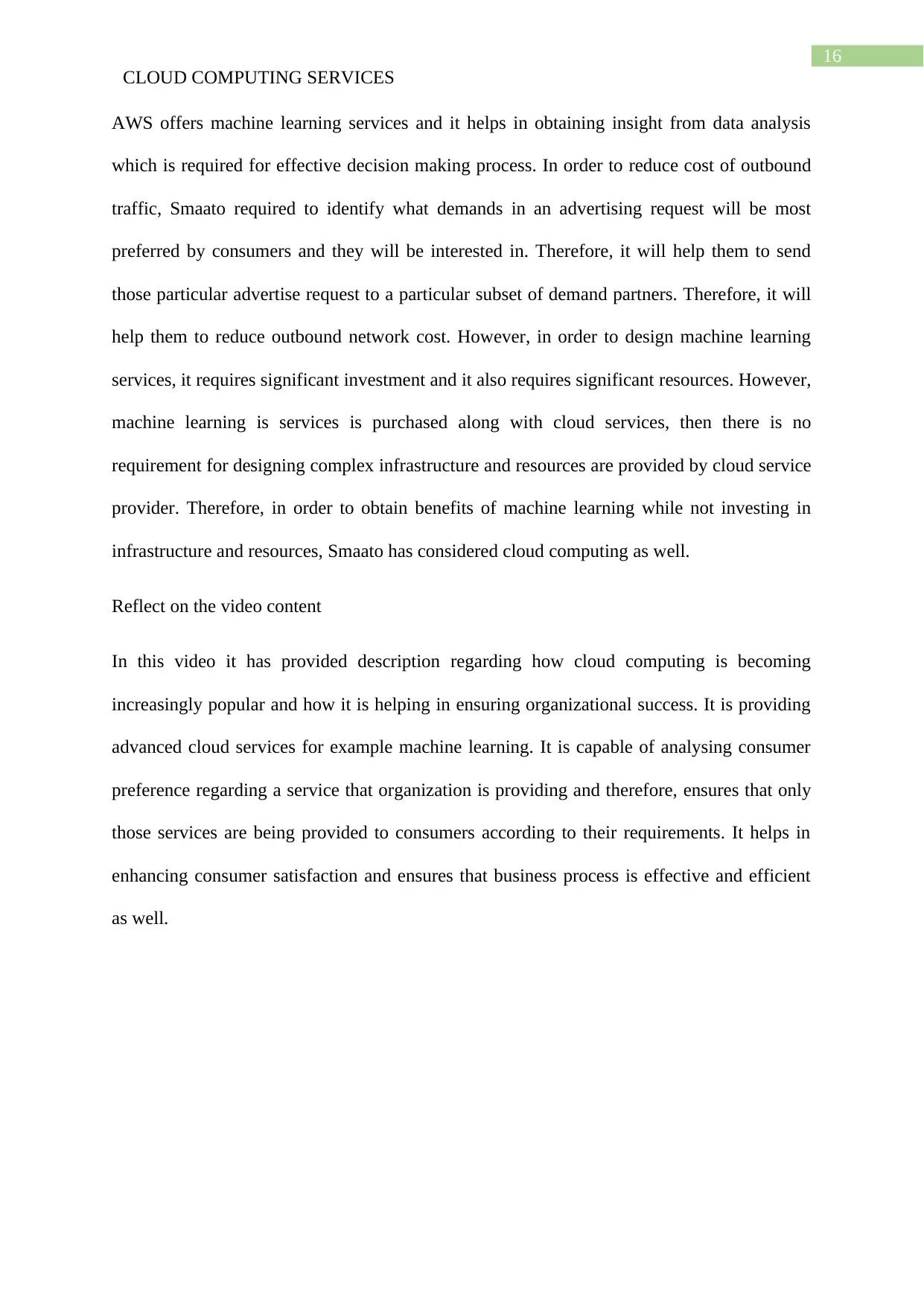
16
CLOUD COMPUTING SERVICES
AWS offers machine learning services and it helps in obtaining insight from data analysis
which is required for effective decision making process. In order to reduce cost of outbound
traffic, Smaato required to identify what demands in an advertising request will be most
preferred by consumers and they will be interested in. Therefore, it will help them to send
those particular advertise request to a particular subset of demand partners. Therefore, it will
help them to reduce outbound network cost. However, in order to design machine learning
services, it requires significant investment and it also requires significant resources. However,
machine learning is services is purchased along with cloud services, then there is no
requirement for designing complex infrastructure and resources are provided by cloud service
provider. Therefore, in order to obtain benefits of machine learning while not investing in
infrastructure and resources, Smaato has considered cloud computing as well.
Reflect on the video content
In this video it has provided description regarding how cloud computing is becoming
increasingly popular and how it is helping in ensuring organizational success. It is providing
advanced cloud services for example machine learning. It is capable of analysing consumer
preference regarding a service that organization is providing and therefore, ensures that only
those services are being provided to consumers according to their requirements. It helps in
enhancing consumer satisfaction and ensures that business process is effective and efficient
as well.
CLOUD COMPUTING SERVICES
AWS offers machine learning services and it helps in obtaining insight from data analysis
which is required for effective decision making process. In order to reduce cost of outbound
traffic, Smaato required to identify what demands in an advertising request will be most
preferred by consumers and they will be interested in. Therefore, it will help them to send
those particular advertise request to a particular subset of demand partners. Therefore, it will
help them to reduce outbound network cost. However, in order to design machine learning
services, it requires significant investment and it also requires significant resources. However,
machine learning is services is purchased along with cloud services, then there is no
requirement for designing complex infrastructure and resources are provided by cloud service
provider. Therefore, in order to obtain benefits of machine learning while not investing in
infrastructure and resources, Smaato has considered cloud computing as well.
Reflect on the video content
In this video it has provided description regarding how cloud computing is becoming
increasingly popular and how it is helping in ensuring organizational success. It is providing
advanced cloud services for example machine learning. It is capable of analysing consumer
preference regarding a service that organization is providing and therefore, ensures that only
those services are being provided to consumers according to their requirements. It helps in
enhancing consumer satisfaction and ensures that business process is effective and efficient
as well.
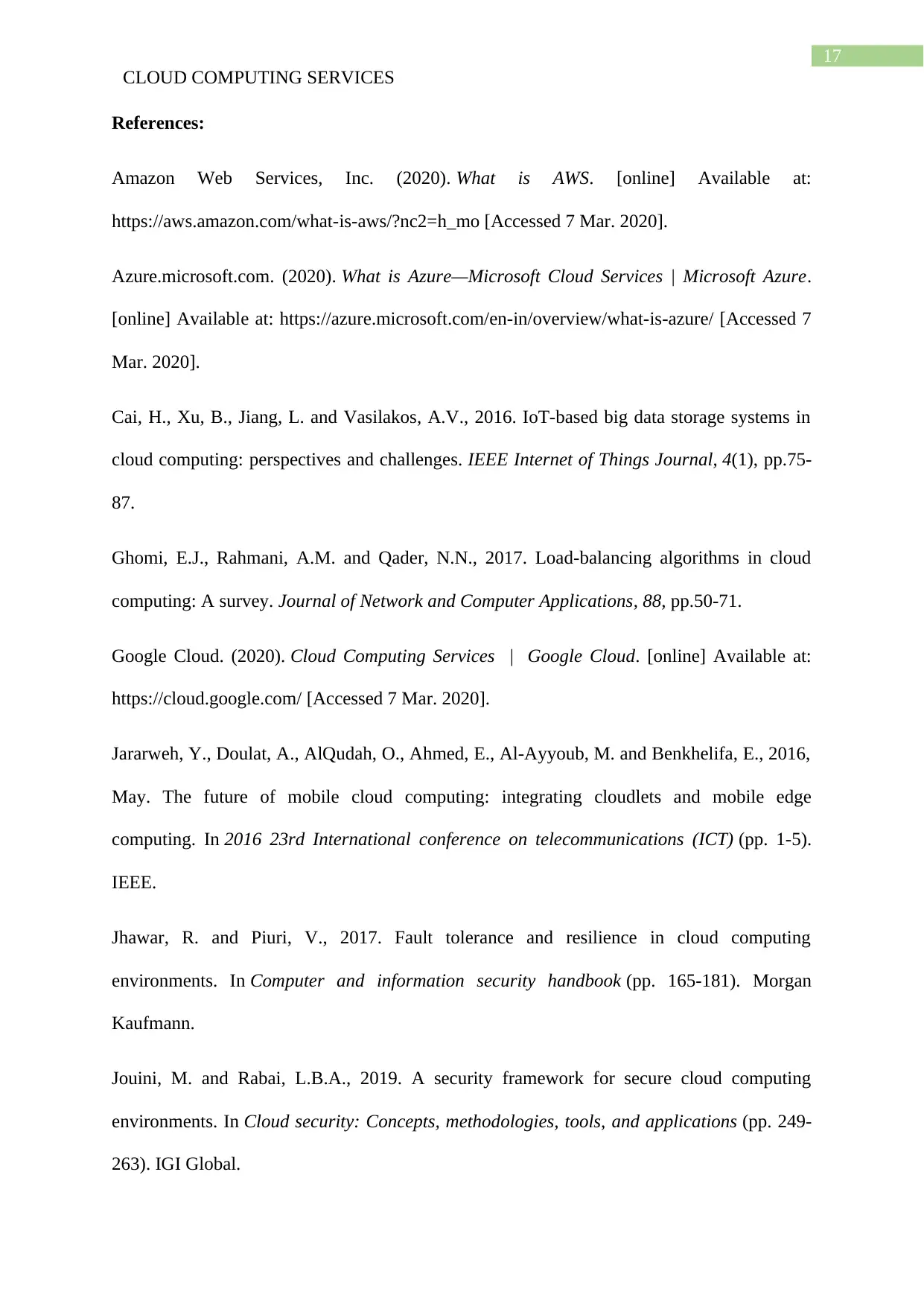
17
CLOUD COMPUTING SERVICES
References:
Amazon Web Services, Inc. (2020). What is AWS. [online] Available at:
https://aws.amazon.com/what-is-aws/?nc2=h_mo [Accessed 7 Mar. 2020].
Azure.microsoft.com. (2020). What is Azure—Microsoft Cloud Services | Microsoft Azure.
[online] Available at: https://azure.microsoft.com/en-in/overview/what-is-azure/ [Accessed 7
Mar. 2020].
Cai, H., Xu, B., Jiang, L. and Vasilakos, A.V., 2016. IoT-based big data storage systems in
cloud computing: perspectives and challenges. IEEE Internet of Things Journal, 4(1), pp.75-
87.
Ghomi, E.J., Rahmani, A.M. and Qader, N.N., 2017. Load-balancing algorithms in cloud
computing: A survey. Journal of Network and Computer Applications, 88, pp.50-71.
Google Cloud. (2020). Cloud Computing Services | Google Cloud. [online] Available at:
https://cloud.google.com/ [Accessed 7 Mar. 2020].
Jararweh, Y., Doulat, A., AlQudah, O., Ahmed, E., Al-Ayyoub, M. and Benkhelifa, E., 2016,
May. The future of mobile cloud computing: integrating cloudlets and mobile edge
computing. In 2016 23rd International conference on telecommunications (ICT) (pp. 1-5).
IEEE.
Jhawar, R. and Piuri, V., 2017. Fault tolerance and resilience in cloud computing
environments. In Computer and information security handbook (pp. 165-181). Morgan
Kaufmann.
Jouini, M. and Rabai, L.B.A., 2019. A security framework for secure cloud computing
environments. In Cloud security: Concepts, methodologies, tools, and applications (pp. 249-
263). IGI Global.
CLOUD COMPUTING SERVICES
References:
Amazon Web Services, Inc. (2020). What is AWS. [online] Available at:
https://aws.amazon.com/what-is-aws/?nc2=h_mo [Accessed 7 Mar. 2020].
Azure.microsoft.com. (2020). What is Azure—Microsoft Cloud Services | Microsoft Azure.
[online] Available at: https://azure.microsoft.com/en-in/overview/what-is-azure/ [Accessed 7
Mar. 2020].
Cai, H., Xu, B., Jiang, L. and Vasilakos, A.V., 2016. IoT-based big data storage systems in
cloud computing: perspectives and challenges. IEEE Internet of Things Journal, 4(1), pp.75-
87.
Ghomi, E.J., Rahmani, A.M. and Qader, N.N., 2017. Load-balancing algorithms in cloud
computing: A survey. Journal of Network and Computer Applications, 88, pp.50-71.
Google Cloud. (2020). Cloud Computing Services | Google Cloud. [online] Available at:
https://cloud.google.com/ [Accessed 7 Mar. 2020].
Jararweh, Y., Doulat, A., AlQudah, O., Ahmed, E., Al-Ayyoub, M. and Benkhelifa, E., 2016,
May. The future of mobile cloud computing: integrating cloudlets and mobile edge
computing. In 2016 23rd International conference on telecommunications (ICT) (pp. 1-5).
IEEE.
Jhawar, R. and Piuri, V., 2017. Fault tolerance and resilience in cloud computing
environments. In Computer and information security handbook (pp. 165-181). Morgan
Kaufmann.
Jouini, M. and Rabai, L.B.A., 2019. A security framework for secure cloud computing
environments. In Cloud security: Concepts, methodologies, tools, and applications (pp. 249-
263). IGI Global.
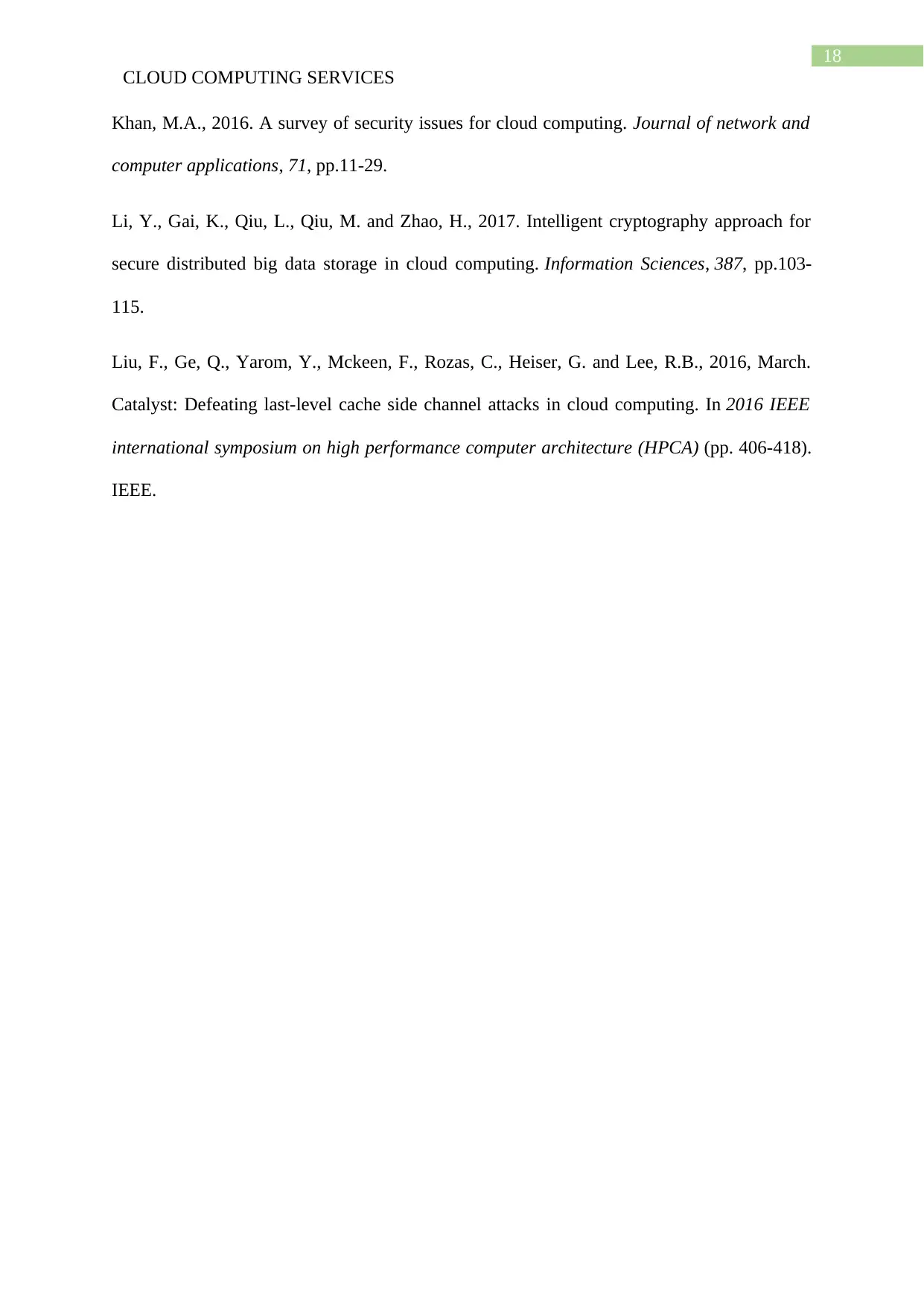
18
CLOUD COMPUTING SERVICES
Khan, M.A., 2016. A survey of security issues for cloud computing. Journal of network and
computer applications, 71, pp.11-29.
Li, Y., Gai, K., Qiu, L., Qiu, M. and Zhao, H., 2017. Intelligent cryptography approach for
secure distributed big data storage in cloud computing. Information Sciences, 387, pp.103-
115.
Liu, F., Ge, Q., Yarom, Y., Mckeen, F., Rozas, C., Heiser, G. and Lee, R.B., 2016, March.
Catalyst: Defeating last-level cache side channel attacks in cloud computing. In 2016 IEEE
international symposium on high performance computer architecture (HPCA) (pp. 406-418).
IEEE.
CLOUD COMPUTING SERVICES
Khan, M.A., 2016. A survey of security issues for cloud computing. Journal of network and
computer applications, 71, pp.11-29.
Li, Y., Gai, K., Qiu, L., Qiu, M. and Zhao, H., 2017. Intelligent cryptography approach for
secure distributed big data storage in cloud computing. Information Sciences, 387, pp.103-
115.
Liu, F., Ge, Q., Yarom, Y., Mckeen, F., Rozas, C., Heiser, G. and Lee, R.B., 2016, March.
Catalyst: Defeating last-level cache side channel attacks in cloud computing. In 2016 IEEE
international symposium on high performance computer architecture (HPCA) (pp. 406-418).
IEEE.
1 out of 19
Related Documents
Your All-in-One AI-Powered Toolkit for Academic Success.
+13062052269
info@desklib.com
Available 24*7 on WhatsApp / Email
![[object Object]](/_next/static/media/star-bottom.7253800d.svg)
Unlock your academic potential
© 2024 | Zucol Services PVT LTD | All rights reserved.





